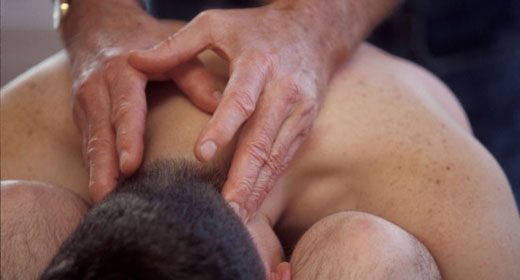by Brandi-Ann Uyemura: Massages were a rare treat until a new baby, a lifetime with scoliosis, and bad posture were wreaking havoc on my neck and shoulders…
And they felt great while I was there. But all that kneading over creaking knots was temporary. I had to keep going back to get any benefits. I tried everything from massage to reiki, but on a hunt for something longer lasting, I decided to try Rolfing.
Rolfing is a type of manipulative therapy developed by biochemist Dr. Ida Rolf in the thirties. She believed gravity and manipulation of a person’s soft connective tissues (fascia) could permanently reform the body to proper alignment. While it’s been around for a while, celebrity endorsements from Dr. Oz and Seattle Seahawks, as well as new and ongoing research on everything from Rolfing’s effects on childhood cerebral palsy to its role on decreasing pain and increasing range of motion, has legitimized this alternative therapy and brought it mainstream.
Rolfers use pressure in their hands to manipulate layers in a person’s body. It may sound like deep tissue massage, but it’s far from it. Valerie Berg, who is an advanced certified Rolfer and member of Rolf Institute faculty, says it’s important not to get the two confused. Unlike massage, Rolfing is not about relaxing a muscle. She says, “It’s about changing the patterns in the body that create postural problems, and pain issues. It’s a very systematic, relationship approach. Everything a Rolfer does is about the relationship through the whole body. It’s never a one spot location. We’re working through fascia not muscles,” she says.
There’s another aspect that makes it different from massage. Far from relaxing, it can be an uncomfortable experience. Richard Podolny, MD, a general practitioner who has been a Rolfer for the past 34-years, compares it to removing a splinter. “It’s sore when you take it out but then you feel so much better.”
Patient Roger Epstein agrees the potential long-term benefit makes the short-term discomfort tolerable. Although traditionally you need a series of 10 sessions to see permanent change, Epstein’s already on his thirtieth. “I’m standing taller and walking with more ease,” says Epstein.
Is Rolfing right for you? While Podolny says anyone can benefit, there are certain people who have the most to gain from it.
Athletes and dancers: Physical stress and injury can cause changes in a person’s body that impede movement. If, for example, an athlete breaks an ankle, that subtle shift can force the body to compensate changing the way they move. Rolfing helps to lengthen connective tissue transforming the body back into alignment due to injury but also increases efficiency and fluidity in movement.
Chronic pain suffers: Rolfing releases painful compression associated with backaches, tension headaches and neck pain.
The aging: Muscles and joints get rigid with age. This can create the physical appearance of aging, shown in heads that tilt forward, curvature in the upper back, loss of ankle movement and hip extension. By preventing this inevitable breakdown, people at any age can “create a young and juicy vital feeling in the body,” says Berg.
Like anything that leads to permanent change, time invested is a requisite. Berg says, “Rolfing is a process. Each session builds on another.” Each segment returns the body to balance. According to her, one session is a drop in the bucket. But in comparison to massage, one session of Rolfing not only made my knots disappear, but I felt lighter the way I feel after a yoga class or talking with a good friend.
One of the less discussed ancillary benefits of Rolfing is emotional. Since it changes old patterns in the body, Podolny says an inevitable consequence is Rolfing’s transformative effect on other areas of your life. Some of his patients who completed at least 10 sessions, ended unhealthy relationships and quit toxic jobs. I’m still early on the journey, but I’m anxious to see what happens next.
Source: Spirituality and Health









































